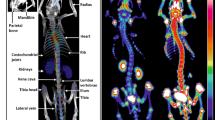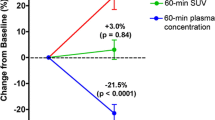Abstract
[18F]fluoride was first introduced in 1962, and rapidly proposed as a radiotracer for bone exploration. The complex [18 F]NaF is injected intravenously, and it dissociates in the blood into Na + and [18 F]fluoride ion. The uptake of [18 F]fluoride results from ionic exchanges between hydroxyl groups of hydroxylapatite to form fluoroapatite and is thus directly related to bone metabolism. Both the blood flow and the osteoblastic activity influence the [18 F] fluoride accumulation, in proportions that are still discussed. [18 F]NaF-PET imaging, using appropriate modeling, can thus noninvasively assess bone metabolism. The advantage of [18 F]fluoride compared to other PET tracers is the synthesis, which is extremely simple and relatively inexpensive: [18 F]fluoride is rendered isotonic with a NaCl solution to form [18 F]NaF. Since the early sixties, the mechanism of uptake of [18 F]fluoride has been extensively studied. The accumulation of [18 F]fluoride in osteoform-ing areas of bone metastases was demonstrated in autopsy series and in rabbit experimental models. In mice, [18 F] NaF-PET clearly identified fractures as increased uptake foci up to 7 weeks after the initial trauma, human bone grafts 2 months after the implantation, and osteoblastic lesions induced by human prostate cancer cells. Lytic lesions from human prostate cancer cells (CL-1 et PC-3) were visualized either as foci of globally increased activity or, most frequently, as rim-like foci, surrounding the edge of the lesions. Quantitative uptake, measured as cps/ pixel/min, was fairly reproducible in femoral and humeral ROIs drawn on four studies over a period of 4 weeks. The relationship between [18 F]NaF uptake and bone formation was clearly established using quantitative modeling in mini pigs, showing correlations of bone blood flow and metabolic activity, with histomorphometric indices of bone formation in the normal bone tissue. Furthermore, in patients with secondary hyperparathyroidism, the [18 F] NaF incorporation rate was correlated with the plasma parathormone level and with the bone formation rate.
Access this chapter
Tax calculation will be finalised at checkout
Purchases are for personal use only
Similar content being viewed by others
Author information
Authors and Affiliations
Editor information
Editors and Affiliations
Rights and permissions
Copyright information
© 2010 Springer-Verlag Berlin Heidelberg
About this chapter
Cite this chapter
Hustinx, R., Beckers, C. (2010). Fluoride PET-CT. In: Fanti, S., Farsad, M., Mansi, L. (eds) PET-CT Beyond FDG A Quick Guide to Image Interpretation. Springer, Berlin, Heidelberg. https://doi.org/10.1007/978-3-540-93909-2_5
Download citation
DOI: https://doi.org/10.1007/978-3-540-93909-2_5
Publisher Name: Springer, Berlin, Heidelberg
Print ISBN: 978-3-540-93908-5
Online ISBN: 978-3-540-93909-2
eBook Packages: MedicineMedicine (R0)




